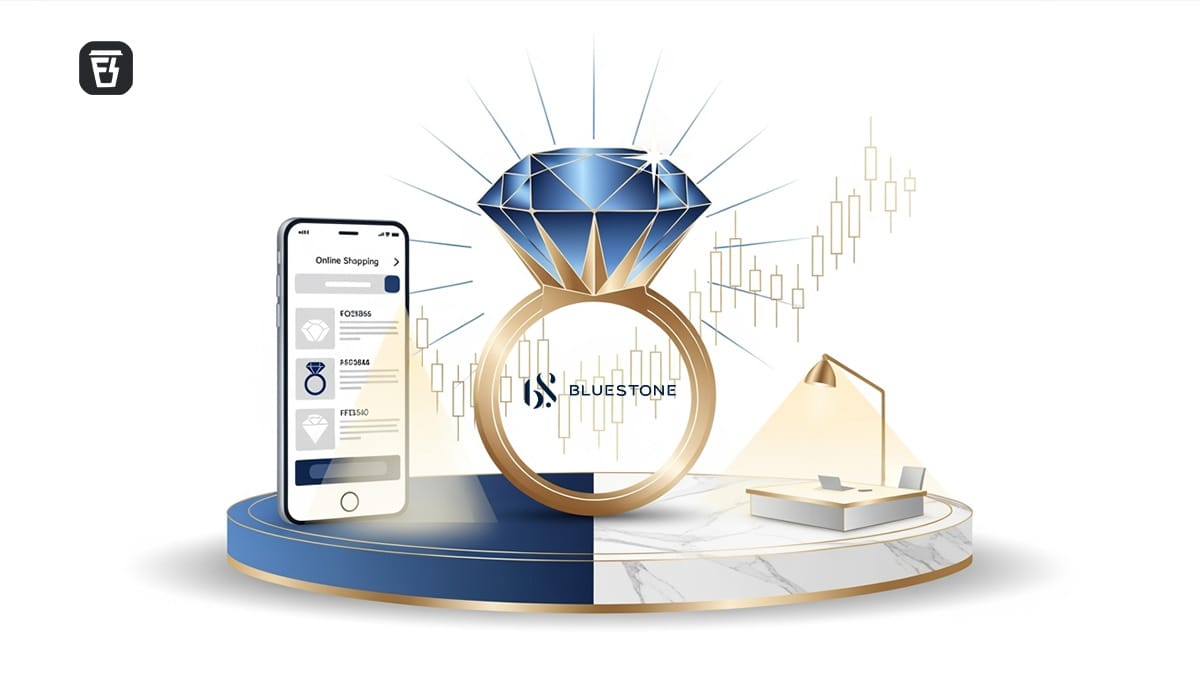The BlueStone Jewellery IPO

In today’s Finshots, we break down the BlueStone Jewellery IPO which opens for subscription on August 11th (Monday) and closes on August 13th.
The Story
If you ask your parents to sum up their investing philosophy in three words, they’d probably say, “Just buy gold”, no matter what boom or bust the stock market is in. Because, you see, Indians and gold share a love story that has outlasted empires and economic reforms. And maybe they’re wired to give you this advice because, for years, gold was their safety net in times of turmoil. Back then, they’d head to the local jeweller, pick out some jewellery and take comfort in the tradition — one passed down from grandparents to parents, and now to us.
Over time, that neighbourhood jeweller may have morphed into a slick, organised jewellery retail chain.
And looking at prices this year, with gold hitting over ₹10,000 a gram, it’s hard to counter their logic.
But while buying jewellery has more or less meant stepping into a shiny store, sipping on chai and carefully inspecting bangles and necklaces, one company wanted to change that ritual.
Back in 2011, when e-commerce in India was still finding its feet and most of us were using phones for calls rather than online shopping, Bluestone Jewellery and Lifestyle popped up with a bold pitch — buy fine jewellery online.
Sure, you had CaratLane at the time, but it was only dealing in solitaires.
So diving into online jewellery was a gutsy move. Buying gold or diamond jewellery without touching it, or having it blessed by your grandmother’s gaze, was unheard of. Because jewellery in India has always been about trust.
And maybe Bluestone realised that. In 2018, it told its customers, “Hey, we’re not asking you to ditch the showroom entirely.” They let you browse and fall in love with the design on your phone or laptop first. If you were convinced, you could order it online or even pop into one of Bluestone’s stores and pick it up. What we call the “omni-channel” model. It had the convenience of digital browsing, with the reassurance of a physical store.
And its growth since then has been nothing short of terrific in a country that’s the second-largest jewellery market in the world (worth about $75 billion, only after China).
For context, when BlueStone began, only around 13% of the sector was organised. The rest was dominated by small, unbranded jewellers trusted for decades by local families.
Fast forward to today, and BlueStone has become the second-largest digital-first jewellery brand in the country, behind CaratLane, which is owned by Titan. It operates over 200 company-run stores and 75 franchise outlets across India, and is the only leading jewellery retailer in India with in-house manufacturing hubs. About 75% of what they sell is made in these facilities.
And BlueStone knows exactly who it’s chasing — customers aged between 25 and 45. This group is smack in the middle of major life events: engagements, weddings, anniversaries. And you bet those milestones almost always involve jewellery shopping. In fact, about 53% of all jewellery sales in the country are tied to weddings.
But tastes are changing. Not every jewellery purchase now waits for a big day. The casual and everyday wear segment — 14 to 18 karat gold pieces you can wear to brunch or work, has grown from 31% to 36% of the market over the last five years. And projections say it could hit 45% by 2029. So it’s no wonder that BlueStone is betting heavily on this shift.
This shift isn’t just theoretical either. It’s showing up in BlueStone’s books. In FY24, it clocked ₹1,303 crores in revenue versus ₹787 crores in FY23. And in FY25 that shot up to ₹1,830 crores. That’s a 51% CAGR (compound annual growth rate) over two years, outpacing big listed players like Titan’s jewellery division, which grew 20% and Kalyan Jewellers, which managed 33% over the same period.
If you’re wondering what’s driving this, it’s probably their control over design and production. Because BlueStone manufactures most of its own jewellery, as we told you earlier, it can launch new designs quickly and cut production costs. That also helps them manage inventory more smartly, which is crucial when your raw materials are gold, silver and platinum. They also tap into something called gold metal loans. Instead of borrowing money in cash to buy gold, jewellers can borrow gold itself, make the jewellery, and repay in gold. It’s a way to reduce exposure to gold price swings.
But here’s the problem. BlueStone hasn’t made a profit. Not once. Losses went from ₹142 crores in FY24 to ₹221 crores in FY25. And the reason is simple. That omni-channel strategy is expensive. Running over 275 stores while also maintaining a top-notch app and website isn’t cheap. Even though they started as digital-first, the numbers now tell a different story. Their online sales’ contribution to revenue has plunged from 15% in FY23 to just 6% in FY25. On the flip side, offline store sales surged from 84% to 93% over the same period. Which means most customers still end up visiting a store before buying. And stores come with rent, staff, and inventory costs. Add to that the marketing expenses needed to compete with legacy giants, and the bill piles up fast.
Still, there’s a glimmer of hope in BlueStone’s repeat customers. In FY23, 34% of revenue came from people who’d already bought from BlueStone before. That’s now 44%. And if BlueStone keeps these customers coming back for more, be it for casual wear or milestone buys, the road to profitability could open up.
And now they’re taking their pitch to the public markets. BlueStone is looking to raise ₹1,540 crores through its IPO. Of this, ₹820 crores will come from a fresh issue and ₹720 crores from an offer for sale by early investors like Accel India, Saama Capital, Kalaari Capital, Iron Pillar and Sunil Munjal. Of the fresh funds, ₹750 crores will go into working capital because stocking gold and diamonds isn’t exactly a low-cost game, and the rest into general corporate purposes.
So should you buy a piece of the company, or just stick to buying BlueStone jewellery?
On one hand, there’s brand recall in the digital jewellery space, fast revenue growth compared to peers, in-house manufacturing that helps with cost control, and a solid positioning to ride the casual jewellery boom.
The designs might tempt you to part with some cash. But when you’re an investor, you look at the bottomline closely, and the company has been loss-making since inception. The business requires a lot of working capital. And that also means less income flowing to profits. Even operating profit margins are around 4%, compared to 10% and 7% for Titan’s jewellery division and Kalyan Jewellers, respectively. Plus, the company doesn’t seem to be utilising its manufacturing facilities to the fullest. Although Mumbai’s capacity utilisation stands at 98%, Jaipur and Surat lag behind at 81% and 68%, respectively.
And here’s something you can’t brush aside. Lab grown diamonds are getting a lot of love in the market. They look just like the real deal but sell for much less. If they make up a big chunk of BlueStone’s future sales, revenue growth could take a hit.
Still, BlueStone’s journey is a reminder of how hard it is to disrupt a business that runs on trust, tradition and touch, while competing with established giants who’ve gone a similar path and built a name.
In chasing a modern jewellery-buying experience, the company’s expenses could balloon faster than its bottom line. So until BlueStone’s books glitter as much as its necklaces, maybe your parents’ advice holds true. Just buy gold. But if you believe that new-age jewellery is the next big thing, then keep an eye on how BlueStone navigates its financials and business over the next few quarters.
Until then…
Don’t forget to share this with your friends, family or even strangers on WhatsApp, LinkedIn and X.
🔊Introducing Pitch Perfect 2025!

If you've been following us for a while, you know our story didn't begin in a corporate boardroom. It started in a college dorm room with 3 broke students who chose to skip placements and chase something bigger.
That something was Finshots.
Today, Finshots reaches over 500,000 readers, and through Ditto, we've empowered 800,000+ Indians to make smarter insurance decisions.
Now, we're looking for the next game-changing idea to back.
Introducing Pitch Perfect 2025 – a flagship startup pitch challenge powered by Zerodha.
So, if you've got a BIG idea that could help Indians get better with money, pitch it to us!
What's at stake:
✅₹10,00,000 in prizes
✅Potential funding from Zerodha Rainmatter
✅All-expenses-paid trip to Bangalore to pitch directly to Nithin Kamath and industry veterans
Ready? 👉Apply Now!
